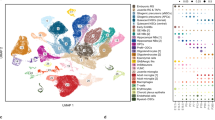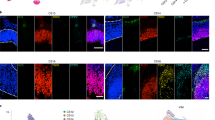Abstract
Globus and Kuhlenbeck1,2 drew attention to the presence beneath the lining of the cerebral ventricles of a distinct cell layer, which they named the subependymal cell plate. They demonstrated it in the brain of human infants, showed it to contain primitive cells and stressed its possible role in the development of certain paraventricular neoplasms. Various workers3–5 have shown the persistence of a subependymal layer in man from foetal to adult life, but except for explaining the origin of “subependymomas”6 the idea that this zone plays a part in the genesis of gliomas has met with little support.
This is a preview of subscription content, access via your institution
Access options
Subscribe to this journal
Receive 51 print issues and online access
$199.00 per year
only $3.90 per issue
Buy this article
- Purchase on Springer Link
- Instant access to full article PDF
Prices may be subject to local taxes which are calculated during checkout
Similar content being viewed by others
References
Globus, J. H., and Kuhlenbeck, H., Arch. Pathol., 34, 674 (1942).
Globus, J. H., and Kuhlenbeck, H., J. Neuropathol., 3, 1 (1944).
Rydberg, E., Acta Pathol. Microbiol. Scand., Suppl. 10 (1932).
Schwarz, H., Goolker, P., and Globus, J. H., Amer. J. Dis. Child., 43, 889 (1932).
Opalski, A., Z. Ges. Neurol. Psychiat., 149 221 (1934).
Scheinker, I. M., J. Neurosurg., 2, 232 (1945).
Allen, E., J. Comp. Neurol., 22, 547 (1912).
Bryans, W. A., Anat. Rec., 133, 65 (1959).
Smart, I., J. Comp. Neurol., 116, 325 (1961).
Altman, J., Anat. Rec., 145, 573 (1963).
Fischer, K., Acta Neuropathol., 8, 242 (1967).
Kershman, J., Arch. Neurol. Psychiat., 40, 937 (1938).
Friede, R., J. Comp. Neurol., 116, 229 (1961).
Spielmeyer, W., Histopathologie des Nervensystems, 1 (Springer, Berlin, 1922).
Baserga, R., Cancer Res., 25, 581 (1965).
Cammermeyer, J., Exp. Neurol., 2, 379 (1960).
Lapham, L. W., Amer. J. Pathol., 41, 1 (1962).
Sjötrand, J., Z. Zellforsch., 68, 481 (1965).
Kreutzberg, G. W., Acta Neuropathol., 7, 149 (1966).
Noetzel, H., and Rox, J., Acta Neuropathol., 3, 326 (1964).
Altman, J., and Das, G. D., J. Comp. Neurol., 126, 337 (1966).
Donaldson, H. H., Mem. Wistar Inst. Anat., No. 6 (1915).
Coppoletta, J. M., and Wolbach, S. B., Amer. J. Pathol., 9, 55 (1933).
Author information
Authors and Affiliations
Rights and permissions
About this article
Cite this article
LEWIS, P. Mitotic Activity in the Primate Subependymal Layer and the Genesis of Gliomas. Nature 217, 974–975 (1968). https://doi.org/10.1038/217974a0
Received:
Revised:
Issue Date:
DOI: https://doi.org/10.1038/217974a0
This article is cited by
-
Epigenetic regulation of aging stem cells
Oncogene (2011)
-
Adult neural stem cells in the mammalian central nervous system
Cell Research (2009)
-
Immigration denied
Nature (2004)
-
Cancer stem cells in nervous system tumors
Oncogene (2004)
-
Neurogenesis in adult primate neocortex: an evaluation of the evidence
Nature Reviews Neuroscience (2002)
Comments
By submitting a comment you agree to abide by our Terms and Community Guidelines. If you find something abusive or that does not comply with our terms or guidelines please flag it as inappropriate.



